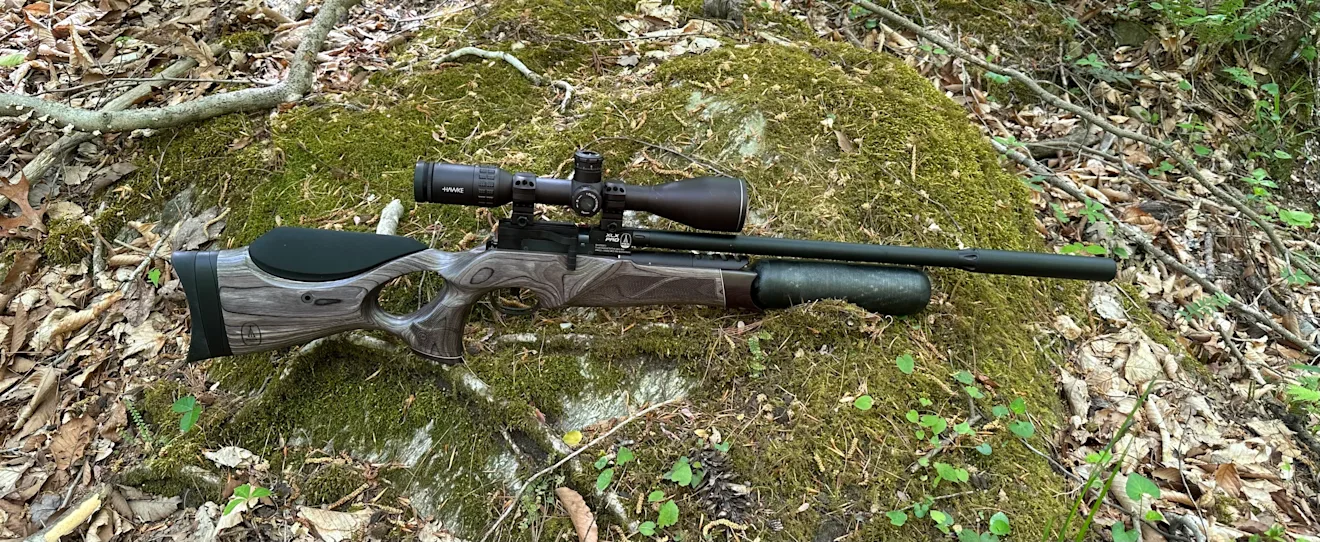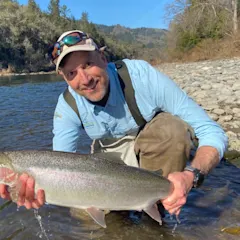While popular in Europe, BSA rifles and pistols haven’t gotten much of a toehold in the American market. That may be changing with the 2024 launch of the BSA website, specifically targeted to the U.S. market. The centerpiece of the company’s U.S. product line is the R12 XLX, an upgrade to the company’s R10 pre-charged pneumatic rifle that has built quite a fan base in the U.K. since it went into mass production in 2009. The R12 is the only rifle available in the U.S. on the company’s website.
Made at BSA’s headquarters in Birmingham, England, the R12 XLX comes in two versions. The base model is the XLX Sporter that features a walnut stock and retails for $1,199. A step up from that gun is the R12 XLX Pro Laminate, which is the same gun but with a black pepper laminate wood stock, a $300 upgrade. The R12 is regulated and available in .22 and .25. I’ve been shooting the R12 XLX Laminate Pro (in .22) extensively for the past couple of months at ranges from 25 to 100 yards. Here are my thoughts.
BSA R12 XLX Pro Laminate Overview
Specs
Type: PCP
Action: Side lever with rotary magazine
Caliber: .22 (tested); .25
Magazine Capacity: 12
Projectile Type: Pellets, slugs
Fill Pressure: 3,360 psi
Max Velocity (lead): 900 fps (.22); 775 fps (.25)
Max Muzzle Energy: 33 foot pounds energy (.22); 40 fpe (.25)
Overall Length: 43.31 inches
Barrel Length: 18.11 inches
Weight: 8.27 pounds
Price: $1,499
Pros
Accurate
Beautiful stock
Excellent trigger
Classic styling
Good power
Quiet
Cons
Lack of power adjustability
Heavy
I’ve always loved the look of classic English air rifles with high-quality walnut stocks. Since the only difference between the two R12 XLXs available in the U.S. is the stock, I requested to test the walnut-stocked Sporter version. Well, the demo rifle BSA sent was the laminate stock version. No complaints here. Sourced from the Italian company Minelli, the thumbhole stock with an adjustable cheek piece is both functional and beautiful. However, that stock incurs a weight penalty of about ⅓ pound over the walnut version.
The rifle is internally regulated for shot consistency, but does not offer an adjustable regulator (or hammer spring) like many other higher-end rifles. While extreme adjustability can be an advantage for competitive shooters or those who just like to tinker, simplicity has its advantages, too. Simply find the pellets and slugs that work best for you, and you’re good to go with less time spent making adjustments and more time spent sending lead down range.
The stock is comfortable, but shooters with smaller hands may find the grip a bit bulky. The adjustable butt plate and cheek piece can help shooters find their best shooting position. The stock features sling studs, which hunters will appreciate during long walks in the woods. Outfitted with one of my favorite scopes—the excellent Hawke Sidewinder Pro FFP 6-24 x 50—this rig weighed in at a stout 10 pounds, 10.6 ounces. The carbon bottle, which holds 480 cc of air, helps a bit with weight and adds to the R12 XLX’s great aesthetics.
The rifle does not come with sights and features an 11 mm dovetail for mounting an optic. The trigger is a two-stage, match-grade adjustable unit that has a smooth first stage and a crisp break. From the factory, the trigger broke at 2.4 pounds. That’s good for the field, but I lightened it to about 1.5 pounds for target work.
The hammer forged barrel is produced by BSA. It’s fully shrouded with a fixed moderator. The 12-shot magazine inserts from the left, which required me to remove the large focusing wheel I had on the Hawke scope. The bolt operation is smooth and precise. The handle of the bolt actually rotates on its shaft during cocking, which is a nice touch.

At the Range
Over a couple of months, the R12 XLX Pro Laminate was the primary air rifle I shot in sessions at my 25-yard backyard range and at my gun club, where I shot mostly at 50 yards but stretched it out to 100 yards once in a while. Both accuracy and power were impressive.
With the gun filled just a tick below its 3360 psi max, the rifle pushed 18.1 grain domed pellets down range at about 920 feet per second. That was good for 34 foot pounds of energy, slightly above the factory-claimed 33 fpe max. More impressive was the consistency. In one long string started with a full tank, 29 of the first 30 shots fell in the 919 to 923 fps range, an outstandingly tight spread. The outlier was a single shot at 914 on the fifth shot.
After the first 30 shots on a full tank, the velocity would start to slip a bit, but I was still able to get about 80 good shots off a fill before tank pressure fell below the regulator. Accuracy was impressive. I shot a variety of domed pellets, and they all performed well. The best were those in the 18-grain family from H&N, Air Arms, and FX. The FX Hybrid Slugs also shot quite well.

Shooting those 18-grain domed pellets off a basic Caldwell Lead Sled, the R12 XLX Pro Laminate consistently shot half-inch groups at 50 yards, even though we were often shooting in breezy spring conditions. I usually bring along a reference rifle to help me judge how much the conditions are impacting my groups. In most cases with the R12 XLX, the reference gun was my tack-driving FX Wildcat MKIII BT—adjusted to shoot 18-grain pellets at 30 foot pounds—and the BSA held its own with the FX.
During one range session, a friend shot a couple of his deer rifles chambered in 30-06. For fun, he taped a hotel key card to the target and bet me I couldn't hit it before he did. He lost that bet. In calm conditions at 25 yards, the rifle shot single, ⅓ inch holes with ease.

A Simple Gun that Performs Well
Unlike 15 years ago, there are loads of great pre-charged pneumatic air rifles available on the American market. Do we need more? Of course we do, especially if those additions provide some variety from current trends that lean heavily on bullpups and tactical, futuristic designs. With their more traditional, classic looks, the BSA R12 XLX Pro Laminate and its slightly more budget-friendly stablemate, the R12 XLX Sporter, stand out.
Though they lack the extreme adjustability that we’re seeing in some other high-end air rifles, that simplicity can be a plus: adjust less and shoot more. If BSA is to gain more fans in the U.S., luring them to the brand with this great rifle is not a bad strategy.



